Novel Techniques in Arthritis & BoneResearch Juniper Publishers
Authored by Magda Havas
Abstract
This study was designed to determine whether pulsed electromagnetic field therapy (PEMFT] could alleviate common symptoms of arthritis such as pain, swelling and immobility and whether it could contribute to overall wellbeing. Five volunteers, all of whom were diagnosed with osteoarthritis, participated in the study. Subjects treated themselves with the Centurion EZY system for 20 minutes, two to three times per week for four weeks. Subjects were tested for various physiological parameters including blood pressure, heart rate variability, balance of the autonomic nervous system (ANS), and stress at the beginning of the trial and at the end. An electro-interstitial scan was conducted to provide additional wellness parameters and a photograph was taken to document range of motion. Results were assessed on a case-by-case basis. PEMFT improved mobility in two of the cases after just one treatment and reduced pain and/or swelling in four of the five cases within 4 weeks. Additionally, general wellness related to cardiovascular health and balance of the ANS of participants improved throughout the course of the study. PEMF therapy may be a useful form of therapy to promote healing and to reduce symptoms of pain, swelling and immobility among patients with osteoarthritis. Furthermore, these treatments may have overall benefits to the health of the cardiovascular and the autonomic nervous system. Further testing needs to be done with a larger sample size to confirm these initial findings.
Keywords: Pulsed electromagnetic field therapy; PEMFT; Centurion EZY system; Osteoarthritis; Pain; Inflammation; Circulation
Introduction
Arthritis is a degenerative disease characterized by joint pain [1]. People suffering from severe forms of arthritis experience an impaired quality of life and are faced with few treatment options that provide long-term relief [2]. The most common types of arthritis are osteoarthritis and rheumatoid arthritis, the former of which is the focus of this pilot study.
Osteoarthritis is a dynamic but gradual disease that can ultimately lead to loss of joint function or significant disablement [3,4]. Currently, there is no cure for arthritis, and treatment options focus mainly on symptom management [1].
Traditional options for treating arthritis include oral non-steroidal anti-inflammatory drugs (NSAIDS), acetaminophen, and corticosteroid injections; which come with side effects such as abdominal pain and damage to central organs [5-7]. Non- pharmacological treatments include diet management to reduce strain on the joints, exercise to improve mobility, splints and joint protection techniques, hot and cold therapy, chiropractics, physiotherapy, acupuncture and more invasive treatments like surgery [1,6]. The relative lack of viable long-term non- pharmacological treatments for arthritis combined with the risks of drug therapy provided the motivation for this study, especially since past studies involving pulsed electromagnetic field therapy (PEMFT) have found no adverse effects on the body, even after prolonged use [8].
PEMF technology was officially approved by the Food and Drug Administration (FDA) in 1979 and has been used to treat various ailments and illnesses for the past 50 years [9]. The therapy was originally used to treat non-union bone fractures and is now used to treat rotator cuff tendinitis, peripheral nerve regeneration, and various other illnesses and ailments of the bone and ligaments causing pain and swelling [10]. Since PEMFT has been recognized to improve circulation and promote healing of inflammation-related pain [1], it shows promise as a treatment for arthritis. Using PEMFT to treat patients with arthritis is not common practice [1,6] and has not been approved by Health Canada. This study attempts to determine if PEMFT (provided by the Centurion EZY System) can alleviate symptoms of arthritis such as pain, swelling and immobility, based on a combination of subjective and objective tests.
Methods
Trent University Research Ethics Board approved this research. The study was performed as a clinical trial and participants were responsible for treating themselves following a short-introduction on how to use the PEMF technology.
Subjects
This study monitored five participants with osteoarthritis all of whom volunteered to be tested. One male and four females between the ages of 60 and 72 were included in this study. These participants were recruited at a local chiropractor's office, where the study took place. All participants were receiving chiropractic care prior to, and throughout the study. Initially, an information session was held at the chiropractor's clinic and nine potential participants arrived, but only seven were present at initial testing, five of whom had diagnosed osteoarthritis. Symptoms of the subjects differed and each participant was monitored individually. Participant codes were used to maintain anonymity throughout the study with age and gender being part of the code. Participant information is provided in (Table 1).

Treatment with PEMF therapy
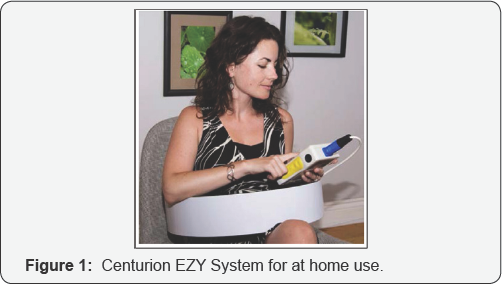
The PEMF device used in this study is the Centurion EZY system, which is intended for home use. The portion of the body to be treated is placed within the device, which is a cylinder large enough to fit around the whole body (Figure 1). The device is easy to use, which allowed participants to treat themselves. Two buttons on a remote attached to the cylinder enabled the user to adjust pulse frequency (from 2, 8, 15, and 30 pulses per second) and duration of treatment (20, 30 to 60 minutes). Participants were instructed to use the therapy two to three times each week over the course of four weeks in the local chiropractic clinic.
All participants began with a treatment at 2 Hz for 20 minutes. The frequency was increased to 15 Hz for an additional week and to 30 Hz the following week provided no adverse symptoms were experienced. None of the subjects experienced adverse symptoms related to PEMFT during the study.
In order to eliminate the placebo effect, two different Centurion devices were used (labeled A and B). Each participant was assigned to one of the two devices, and all participants were told that one device was non-functioning. In reality, both devices were fully functioning and therefore allowed us to treat all participants while minimizing the placebo effect.
Subjective questions
Before and after each treatment, participants completed a questionnaire where they rated their symptoms on a scale of 0-10 for each location of arthritis that was being treated. For example, if a participant experienced pain, and immobility; they would rate their pain and immobility before and after each treatment on an increasing scale of 0-10 (where 10 is the most severe). Participants were also contacted weekly to document their experience. General questions asked were:
i. Have you experienced any changes in symptoms over the last week?
ii. Has the device caused any discomfort?
iii. Have you experienced any change over the course of the study?
Objective monitoring
Subjects were tested for various health parameters at the beginning and at the end of the four-week study. Devices used included blood pressure monitoring; Max Pulse to monitor heart rate variability and to provide information on stress response; ESTeck to assess the interstitial environment; and photography to document changes in mobility, swelling, and disfigurement. Each participant was monitored before exposure to PEMF therapy and at the end of the four-week study. These monitoring techniques are described below.
Range of motion
We photographed each subject to document changes in range of motion and deformities at the beginning and at the end of the study. We also photographed subjects after their first 20-minute treatment to determine immediate changes, if any.
Heart rate variability and stress response
Max Pulse is an FDA Class II medical screening device that provides measurements using photoelectric plethysmography, accelerated plethysmography, and other technologies to access overall cardiovascular and ANS wellness. It provides information on the relative balance of the sympathetic and parasympathetic autonomic nervous system (ANS), stress level, condition of blood vessels, and heart health (Medicore, Max Pulse User Manual).
The electro-interstitial environment
The ESTeck electro-interstitial body-scan works in conjunction with the data from the Max Pulse to provide an assessment of overall health (www.ldteck.com). ESTeck is commonly used by healthcare practitioners to track changes in a patient's health and wellbeing. ESTeck provides information about heart rate variability, heart rate, stress, systolic and diastolic pressure, systematic vascular resistance, dissolved blood oxygen, blood volume, maximum oxygen volume, and a homeostasis score. Analysis involves bioelectrical impedance. From this, it is easy to see progression or regression in each field in order to determine if health is changing. For ESTeck assessments, the patient is seated with feet and hands placed flat on separate metal sensor plates, and with two electrodes positioned on the forehead above the eye brows. A finger pulse oxy meter probe is used to estimate percentage of hemoglobin that is saturated with oxygen (SpO2). Additional information provided for this program to operate optimally is age, gender, height, weight, blood pressure, ethnicity and level of physical activity.
Results
Each case was examined individually since symptoms and areas affected by arthritis differed.
Case 1:F64
Case 1 is a 64-year-old female who was diagnosed with arthritis in the hands and feet 34 years ago. She is five feet tall, 165 pounds, and reports very light daily activity. The participant experiences symptoms of arthritis throughout her body and also experiences pain and mobility issues in her arms. Case 1 suffers from severe finger and hand and foot deformities and had the most advanced arthritis in the study (Figure 2).
Her major concerns were weakness and immobility (Table 1).
This individual received a total of nine 20-minute treatments to shoulders and feet.
Her major concerns were weakness and immobility (Table 1).
This individual received a total of nine 20-minute treatments to shoulders and feet.
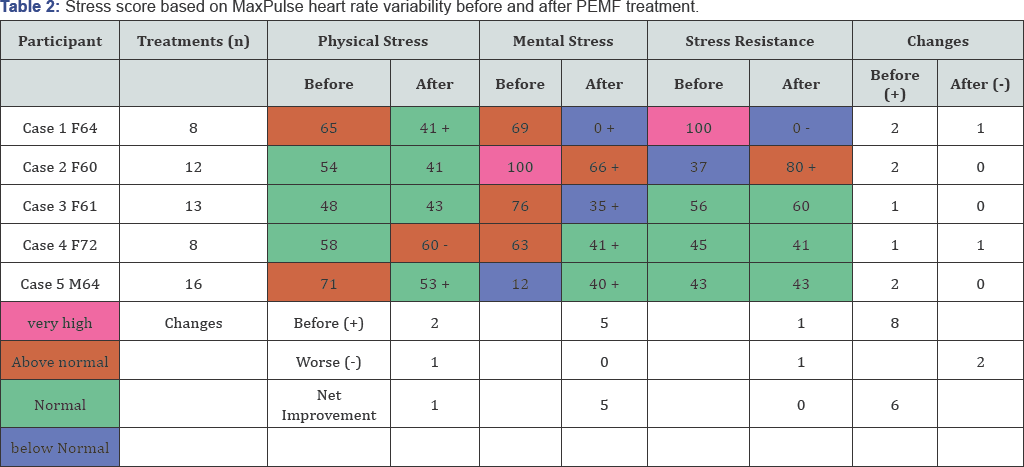
Changes following PEMFT are indicated by symbols for better (+) and worse (-) for each case.
Initially, Case 1 could not form a fist and had difficulty raising her right arm above her head and both arms behind her back. After an initial treatment she could form a fist and had more mobility of her arms that continued to improve with time (Figure 3). Mobility of her feet also improved slightly. Weakness was a major concern and there was some evidence that 15 Hz frequencies alleviated some of her weakness especially in her hands and arms. Despite the fact that Case 1 had the most advanced form of arthritis, improvement in mobility was both rapid and dramatic, which shows promise for those with severe arthritic symptoms. Case 1 also experienced reduced physical and mental stress during the study (Table 2). PEMFT significantly reduced arthritic symptoms for Case 1. She has elected to continue with treatments beyond the four-week test period.
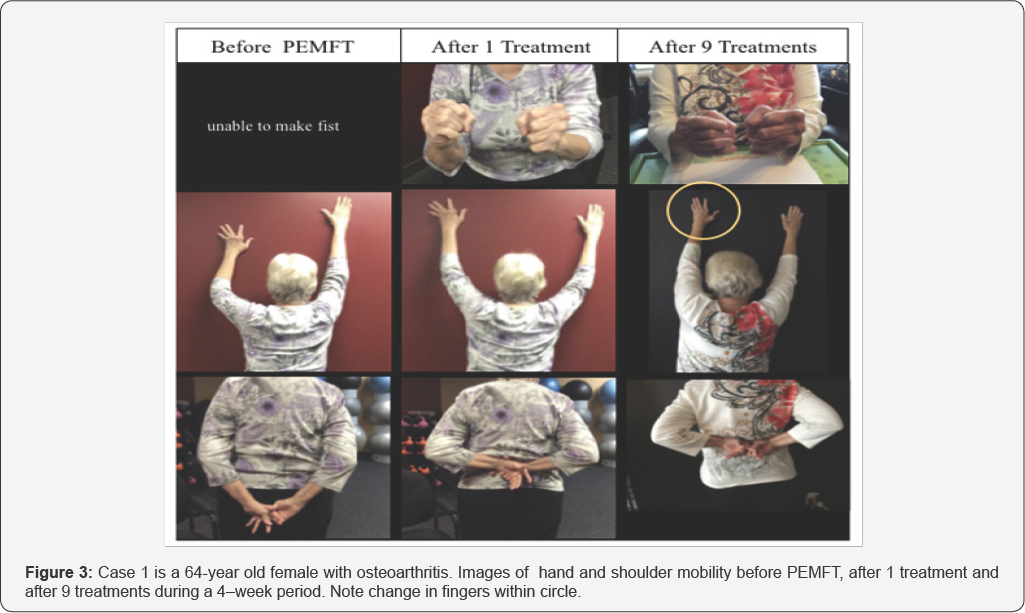
Case 2:F60
Case 2 is a 60-year old female with arthritis in the left hand and right shoulder that was diagnosed approximately seven years ago. The individual is 5 feet 8 inches and 160 pounds, and reports about two hours per week of physical activity. Arthritis in the left hand has produced a finger deformity in the pointer finger, and the Case 2 notes that the pain from this finger has been spreading to other fingers over the past several months. This individual attends physiotherapy once weekly, but did not attend physiotherapy for two weeks during this study, and upon returning to the physiotherapist the doctor noted that mobility had improved during that time. Note that this individual stopped doing physiotherapist-recommended exercises at home, and the improvement occurred while the participant was using the PEMF therapy. This individual received a total of 12 treatments.

The progression of photos for Case 2 show that her right arm was able to extend slightly further in the "after 1 treatment" photo, and was able to extend significantly further in the "after 12 treatments" photo (Figure 4). The hand images for Case 2 show improved mobility in the fingers after the first treatment and she experienced significantly less pain and less swelling of both hands and shoulder following PEMF treatment. Mental stress reduced and stress resistance increased for Case 2 based on Max Pulse HRV (Table 2). Clearly PEMFT reduced symptoms of arthritis experienced by Case 2 and also reduced her level of mental stress. She has also elected to continue with weekly PEMF treatments.
Case 3:F61
Case 3 is a 61-year-old female who was diagnosed with osteoarthritis in the neck and lumbar 12 years ago. This participant suffered from mouth cancer in the past, and the radiation treatment for this left her with chronic jaw pain. Case 3 is 5 feet 2 inches, 120 pounds and has a moderate activity level. She received 13 PEMF treatments in total. Case 3 experienced a slight decrease in pain and swelling of her neck and a decrease in swelling of her lumbar region following PEMFT but no noticeable change in mobility, which was her major concern. This subject had a significant decrease in mental stress (Table 2) and considerable improvement in six of the nine parameters for her cardiovascular and autonomic nervous system by the end of the study including a normal heart rate, a balance of her ANS based on HRV, and normalized specific oxygen, estimated blood volume and homeostasis score (Table 3). Improved heart rate variability reflects the body's ability to moderate the autonomic system and improved homeostasis score represents the body’s ability to adapt to changes such as disease or illness [11]. While PEMFT did not reduce her primary concern of limited mobility in the neck and lumbar regions, improvements in her cardiovascular health and ANS were noted during this study.
Case 4:F72
Case 4 is a 72-year old female, who was diagnosed with osteoarthritis in the right shoulder and left knee approximately two years ago. This individual is 5 feet and 148 pounds, and reports moderate daily activity. This individual experiences worse pain in the knee when walking. Case 4 received a total of eight treatments. Her major concerns were with discomfort and immobility, neither of which improved during this study. She reported no noticeable physical changes during the testing period. Mental stress was much lower at the end of the study and physical stress was marginally higher (Table 2). Her ANS was better balanced and her cardiovascular response was mixed (Table 3). Case 4 improved the least of the 5 Cases tested.
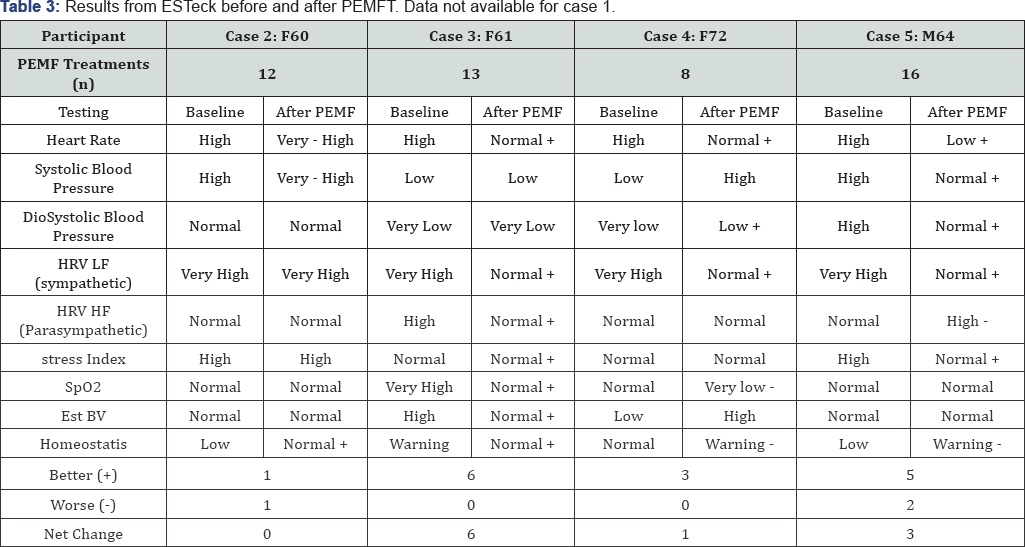
Case 5: M64
Case 5 is a 64-year old male, who was diagnosed with osteoarthritis in the hips, knees and lower back prior to 2012. He also experiences pain from past injuries, including a torn meniscus in the knee and a lower back injury and his symptoms become worse in cool, damp weather. He is 5 feet 10 inches and weighs 212 pounds. This individual received 16 treatments. He increased physical activity and changed his diet resulting in weight loss during the study, which may explain some of the results observed.
His major concerns were pain and immobility (Table 1). A slight but insignificant change was noticed in the pain associated with his hip. Case 5 stated that he experienced slightly better mobility and less pain while walking. Based on Max Pulse, subject showed improvements in both physical and mental stress (Table 2), which was supported by the ESTeck stress index. According to ESTeck, Case 5 shifted from sympathetic to parasympathetic dominance and his blood pressure changed from high to normal (Table 3), which may be due in part or entirely to his weight loss.
Discussion
The use of magnets for the purpose of healing dates back to Plato, Aristotle and Homer, and during the renaissance, magnets were used to minimize inflammation [1]. In short, this is not a new technology, and is surrounded by a large field of research. The use of magneto therapy began soon after World War II in Japan, and then the technology travelled to Europe [7]. From 1960-1985 it was commonplace for European countries to design and create their own version of a magneto therapy device. During this time, literature on the topic began appearing, the most significant of which treated 2700 patients with 33 different pathologies. In the 1970's, the therapy was used to treat nonunion fractures, and since then it has been approved by the FDA for that purpose. Ten years after the initial approval by the FDA for non-union fractures, the technology was approved for treatment of pain and edema in soft tissues [7]. Prior to approval from the FDA, several trials were performed in order to monitor efficacy, and the success rate of these trials averaged from 7080% [9].
Pulsed electromagnetic field therapy (PEMFT) is a technology that uses pulsed electromagnetic fields to stimulate either a specific area of the body to improve specific symptoms, or the whole body to improve overall wellbeing. The higher the frequency used in the therapy, the more often the electromagnetic fields are pulsed through the device. For example, 2 Hz means two pulses per second, and 30 Hz means thirty pulses per second. Various frequencies and waveforms have been found to have different effects on various disorders [7,12].
PEMFT does not heal the body, but rather aids the body in repairing itself. The exact mechanisms that occur in the body are complex and not entirely understood, however, a large body of science surrounds this topic and there is a general consensus in how and why the therapy works among the research community [7,13].
PEMFs are meant to stimulate piezoelectric potentials using Faraday currents in extracellular fluid [9]. The movement of electrolytes in bone channels and fixed charges generate streaming potentials cause piezoelectric potentials, so the PEMFT is mimicking a natural phenomenon that occurs in the body [14]. In other words, PEMFT generates the same changes within cartilage and bone as natural cartilage compression produced by movement, which causes the fluid and accompanying electrolytes surrounding this cartilage and bone to circulate [14]. This circulation of extracellular fluid is believed to be key in the healing process as influenced by PEMFT.
The use of PEMFs also creates a forced vibration of free ions on the plasma membrane of each cell, which can in turn affect the cell’s electrochemical balance and also its function [15]. As free ions in the extra cellular matrix are circulated, cartilage repair should improve and pain should subside [14,16]. Along with this, mobility should improve as well as minor-to-moderate disfigurements.
PEMFT has also been shown to encourage nerve regeneration in vivo studies, caused by an up-regulation of A2A adenosine receptors, which modifies the response in human neutrophils [16]. Cells in the extracellular fluid as well as cells in nerves are altered, encouraging healthy growth and regeneration, and generally improving healing and well being [9,16].
Today, it is quite common to see PEMFT being used in doctors' offices and clinics to remedy an array of ailments [8]. Studies have confirmed that PEMFT can be helpful in treating osteoarthrosis, abnormal ossification, osteoporosis, nasosinusitis, multiple sclerosis, Parkinson's disease, spastic paresis, diabetic poly neuropathy and retinopathy, vegetative neurosis, peptic ulcers, colon irritable ulcers, trophic ulcers, and several other health complications [17].
The purpose of the current study was to determine whether PEMFT using the Centurion EZY system can alleviate symptoms of osteoarthritis. Of the five cases tested, two experienced significant improvement in mobility by the end of the study and one of these experienced improvement after the first 20-minute treatment. Slight to significant reductions in pain and swelling were reported by four of the five cases. Furthermore, improvement in cardiovascular health and in ANS balance was also observed in four of the cases by the end of the four-week test period.
Several studies have been done over the past several decades to determine if PEMF therapy would be useful to treat arthritis. Overwhelmingly, the conclusion to these studies is that PEMFT would be a valuable therapy to those suffering from various types of arthritis. Human studies that have been conducted include PEMF to treat osteoarthritis in the knee, the cervical spine, osteoarthritis in general, and treatment of various other arthritis symptoms [3,4,8,10,18-21]. Each of these studies were done differently, using different methods and different versions of technology, but all resulted in the conclusion that PEMF technology would be helpful in treating arthritis in some capacity [8]. Some of these papers also looked at the toxicity of using PEMFT, and found that there was no measurable toxicity or side effects to the use of a PEMF device [8].
Experiments have also been performed on various laboratory animals with arthritis and PEMFT is used in veterinary clinics to treat horses and other large mammals as well as small domestic pets for various ailments ranging from broken bones to soft tissue healing to pain reduction. Use of animals to test the technology provides more conclusive evidence of the effectiveness of PEMFT Again, these studies concluded that the technology being used caused no adverse effects and that PEMF therapy may be useful to treat arthritis in humans as well [13,14,22-29].
Additionally, studies have been performed in vitro to determine the effect PEMF has on cells. These studies determined that PEMF exposure could trigger cell proliferation and glycosaminoglycan synthesis in cartilage, thereby altering the extracellular fluid surrounding the cartilage, which encourages healing of the cartilage [30,31].
According to Ganesan [1], analysis of various studies conclusively shows that PEMF not only alleviates arthritic pain but it also affords chondro protection, exerts anti-inflammatory action and helps in bone remodeling and this could be developed as a viable alternative for arthritis therapy. Overall, PEMFT appears to be a promising technology to treat arthritis, and it will be used more frequently in the future.
Conclusion
Pulsed electromagnetic field therapy (PEMFT) is used globally for a number of ailments ranging from rapid recovery following surgery to healing of non-union bone fractures to reduced depression with no obvious side effects after prolonged use. PEMFT has been documented to improve circulation, reduce inflammation and alleviate pain and as such may be a useful treatment for people suffering from arthritis. According to this study, PEMFT, generated by the Centurion EZY system, alters symptoms of arthritis that include some combination of reduced pain, reduced swelling and improved mobility. Responses varied among the volunteers tested with some showing immediate and significant improvements after a single treatment and others are having minimal effects by the end of the test period. PEMFT was also associated with improved overall wellness related to cardiovascular health and autonomic nervous system balance and manifested itself as a form of stress reduction and sympathetic down-regulation. Use of this technology, during the four-week period, resulted in no obvious harmful effects. Clearly, this pilot study needs to be replicated with more cases and a longer test period to verify the results. Should they be verified, PEMFT may be an effective, easy to self-administer, non-invasive treatment with no known side-effects for those suffering from minor to severe osteoarthritis. Benefits in terms of patient wellbeing and reduced health care costs are likely to be considerable.
To
Know More About Novel Techniques in Arthritis & Bone Research Please Click
on:
https://juniperpublishers.com/ntab/index.php
To Know More About Open
Access Journals Publishers Please Click on: Juniper
Publishers
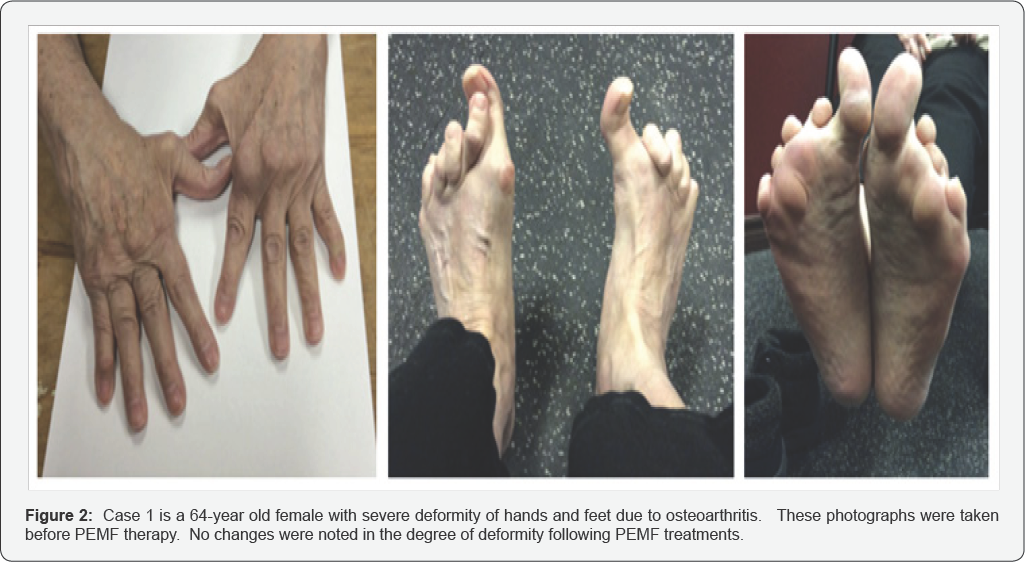




Its a great pleasure reading your post.Its full of information I am looking for and I love to post a comment that "The content of your post is awesome" Great work.
ReplyDeletePEMF Devices
I think this is an informative post and it is very useful and knowledgeable. therefore. I would like to thank you for the efforts you have made in writing this article.
ReplyDeletepemf mat reviews
This is really a nice and informative. containing all information and also has a great impact on the new technology. Thanks for sharing it
ReplyDeletepemf mats
This blog is a punchy bit of composing, as it has a solid impact.
ReplyDeleteclick on it
We are a full-service drywall company located in Bend, Oregon. Our drywall contractor offers all phases of drywall from installation to custom texture read the full info here Drywall Installation Bend Oregon.
ReplyDeleteWhat a fantabulous post this has been. Never seen this kind of useful post. I am grateful to you and expect more number of posts like these. Thank you very much.
ReplyDeletewhat is pemf technology
Nice blog..! I really loved reading through this article.
ReplyDeleteQRS Electromagnetic Field Therapy Mat
Thanks for sharing nice information about plastic finger support protector for fingers joint pain with us. i glad to read this post.
ReplyDeleteReally loved your blog post. If you are looking for physio in Bhopal, check out here
ReplyDeletePhysiotherapy in Bhopal
Employee Wellness Physio in Bhopal
Great work man you have post a great post it will help people very much keep it do more for people like that Here Are the Best ‘Gossip Girl’ Reboot Looks From the Set.
ReplyDeleteGreat post it will help people very much. If you are looking for Cardio pulmonary Rehabilitation Physio in Bhopal check out here
ReplyDeleteCardio pulmonary Rehabilitation Physiotherapy
We have sell some products of different custom boxes.it is very useful and very low price please visits this site thanks and please share this post with your friends. study health sciences in university of New Brunswick Canada
ReplyDeleteDuring this website, you will see this shape, i highly recommend you learn this review. Glownar
ReplyDeleteThanks for nice share nice blog with me. it is very interesting and attractive content with meaning full words on pulsed electro magnetic field.
ReplyDeleteWonderful article post. If someone is looking for pain relief physiotherapy in Bhopal city, you can see here
ReplyDeletePain Relief Physiotherapy in Bhopal
Auto buy trustpilot reviews
ReplyDeleteProfits - Review, is another make money online product by Ewen Chia. Ewen Chia also developed such hits as "Super Affiliate Cloning" and "Newbie Cash". Let us look at what his latest product is offering.
Great sharing. If someone is looking for geriatric physiotherapy in Bhopal city, you can see here
ReplyDeleteGeriatric Physiotherapy in Bhopal
has been a practicing licensed massage therapist for almost two decades. She is now thrilled to share her no-nonsense advice to other licensed massage practitioners to help them find their own way into their practice or improve the one they have. 송파구 출장안마
ReplyDeleteYour post is very helpful to get some effective tips to reduce weight properly. You have shared various nice photos of the same. I would like to thank you for sharing these tips. Keep updating more simple tips like this. pulsed electromagnetic field therapy
ReplyDeleteGreat Article.To know more about Home Health Care in Bangalore visit ICAM Wellcare for dedicated, focused, and offer personalized, evidence-based treatment plans
ReplyDelete